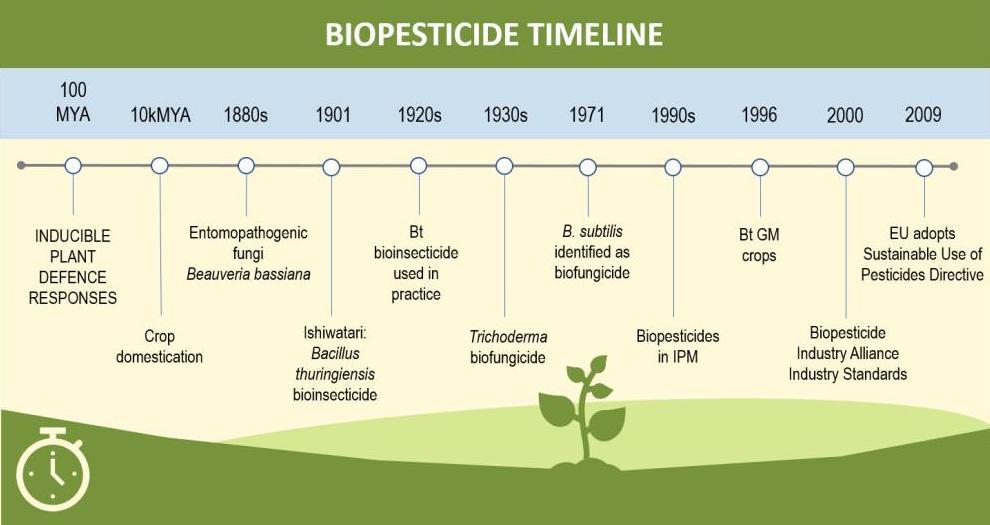A (Surprisingly Long) Biopesticide Timeline
The application of biopesticides in plant protection is certainly not a new innovation. A few examples are presented in the following timeline:
The efficacy of biopesticides is — to a large extent — driven by inducible plant defense responses evolved over more than 100 million years. These defense responses have proven to be sufficiently effective to permit the evolution of a complex flora.
Crop pests and diseases, as well as the activity of beneficial insects, have been known since the beginning of agriculture, some 10 thousand years ago.
In 1835, Agostino Maria Bassi identified the ascomycetes fungus Beauveria bassiana as a disease of silkworm. By the turn of the 19th century, scientists were reporting on the biology and pathology of entomopathogenic fungi.
In 1901, a bacterial pathogen of silkworms was discovered, subsequently named Bacillus thuringiensis (Bt). Field trials with Bt to control the European corn borer were conducted in the late 1920s, and in 1938 the first commercial Bt preparation was introduced.
Today, entomopathogenic bacteria are widely used to control insect pests, typically via their digestive tracts, while Bt-toxin crystals are the basis of microbial-derived bioinsecticides, which are activated upon ingestion by lepidopteran insect pests, leading to cell disintegration and insect death.
In the 1930s, several species of the soil-borne Ascomycetes fungus Trichoderma began to be used as biocontrol agents against fungal diseases of plants, through the mechanisms of antibiosis, parasitism, plant-defense induction, and competition.
In 1971, the endospore-forming bacterium Bacillus subtilis was identified as a biofungicide able to supress seed and seedling disease.
Bacillus strains such as B. subtilis, B. amyloliquefaciens, and B. licheniformis produce antimicrobial metabolites such as lipopeptides, which exhibit a broad antimicrobial spectrum and surfactant activity.
Today, B. subtilis and its variants are among the most-used biofungicides to control soil and seed-borne pathogens, as well as foliar plant diseases.
With the increased focus on Integrated Pest Management (IPM) in the 1990s, interest in genetic modification (GM) and biopesticide development grew, and in 1996 the first insect-resistant Bt GM crops were introduced. Bacillus thuringiensis functions as an insecticide when its toxin (Bt toxin) is directly incorporated into plants through the use of genetic engineering.
The increased public awareness of the benefits of Integrated Pest Management strategies, which combine the use of biopesticides with natural predators, pest-resistant varieties, cultivation techniques, and conventional crop protection chemistries is a key factor driving the growth of the biopesticide market.
Reflecting the increased contribution of biological strategies in crop protection, the Biopesticide Industry Alliance (changed to Biological Products Industry Alliance in 2017) was initiated in 2000 to ensure industry standards and increase awareness of biopesticides and biologicals in agriculture.
In 2009, the EU adopted the Sustainable Use of Pesticides Directive (2009/128/EC) promoting the implementation of biopesticide-based integrated pest management solutions.
Thanks for reading. Please feel free to read and share my other articles.
For more information, visit BioScience Solutions, which contributes to the development of sustainable crop protection solutions by providing independent strategic R&D management and scientific support to agchem and biosolutions businesses developing science-based products.







